It’s barely mentioned in saddle fit or anatomy books, yet the muscle Spinalis cervicis can hugely impact on the spinal health and movement of the horse, particularly with poor tack fit.
Meet muscle Spinalis cervicis et thoracis, a far more important muscle than is generally realized. As a deep muscle, it’s influential in mobilizing and stabilizing that hidden area of the spine at the base of the neck, the cervico-thoracic junction, deep between the scapulae.
Where to Find this Muscle
As part of the deeper musculature, Spinalis is as hidden in books as it is in life. Usually, it’s a single entry in the index.
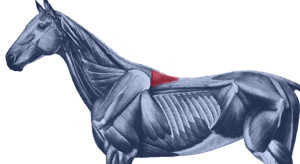 At best, it has no more than a bit part in anatomical illustrations, usually as a small triangular area at the base of the withers. This is also where we can palpate it.
At best, it has no more than a bit part in anatomical illustrations, usually as a small triangular area at the base of the withers. This is also where we can palpate it.
The reality is quite a bit more interesting. It’s actually a muscle of three parts – dorsalis, thoracis and cervicis. These names denote its many insertions, for it links the spinous processes of the lumbar, thoracic and cervical vertebrae.
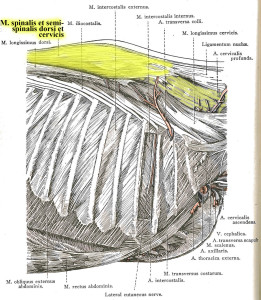 Further back along the spine, it lies medially to Longissimus dorsi, and in fact integrates with this larger, better known muscle, attaching to the processes of the lumbar and thoracic vertebrae.
Further back along the spine, it lies medially to Longissimus dorsi, and in fact integrates with this larger, better known muscle, attaching to the processes of the lumbar and thoracic vertebrae.
- When it reaches the withers, it becomes more independent, attaching to the processes of the first half dozen thoracic vertebrae (T1-T6). Here, the cervical and thoracic portions overlap and integrate to share a common attachment. (The part we palpate, at the base of the withers, is the thoracic section.)
- Heading into the neck, as Spinalis cervicis, it attches to the last 4 or 5 cervical vertebrae (C3/C4-C7). Only the lamellar portion of the nuchal ligament runs deeper than this muscle.
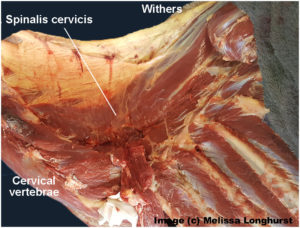 Its integration with other muscles is complex, and its close relationship with Longissimus dorsi partially explains why it doesn’t get much consideration as a muscle in its own right.
Its integration with other muscles is complex, and its close relationship with Longissimus dorsi partially explains why it doesn’t get much consideration as a muscle in its own right.
It is the more independent section, Spinalis cervicis, between withers and neck, that we are interested in, although its influence is present along the entire spine.
© All text copyright of the author, Jane Clothier, https://thehorsesback.com.
What Does Spinalis Do?
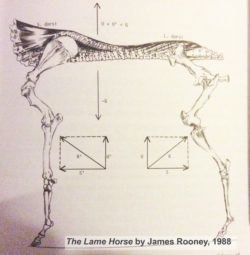 In his 1980s’ Guide to Lameness videos, Dr. James Rooney, first director of the Gluck Equine Research Center, University of Kentucky, referred to Spinalis as part of the suspension bridge of muscles supporting the spine (Longissimus dorsi achoring from the lumbosacral vertebrae, Spinalis thoracis et dorsalis from the upper thoracics). He also refers to this extensively in The Lame Horse (1988).
In his 1980s’ Guide to Lameness videos, Dr. James Rooney, first director of the Gluck Equine Research Center, University of Kentucky, referred to Spinalis as part of the suspension bridge of muscles supporting the spine (Longissimus dorsi achoring from the lumbosacral vertebrae, Spinalis thoracis et dorsalis from the upper thoracics). He also refers to this extensively in The Lame Horse (1988).
In fact, the suspension bridge analogy only really makes sense if Spinalis dorsi is considered.
Spinalis cervicis is usually credited with a role in turning the head to left to right, and raising the head.
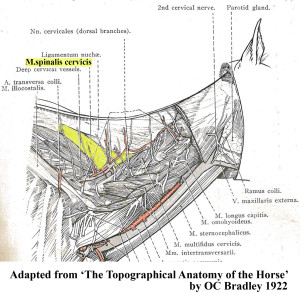 Older texts, such as Bradley’s 1922 veterinary dissection guide, Topographical Anatomy of the Horse, mention its role in stabilizing the spine.
Older texts, such as Bradley’s 1922 veterinary dissection guide, Topographical Anatomy of the Horse, mention its role in stabilizing the spine.
This creates a point of interest. Given that the nuchal ligament (lamellar portion) doesn’t attach to C6 and frequently only weakly with C5 (see the findings of anatomist Sharon May-Davis, in this earlier article ), Spinalis cervicis suddenly appears pretty important in stabilizing and lifting the base of the neck, particularly as it does so at the point of greatest lateral bending.
Spinalis and Poor Saddle Fit
Anyone who has been involved in close examination of the horse’s back will recognize Spinalis thoracis where it surfaces close to the skin, on either side of the withers.
When a horse has been ridden in an overly tight saddle, this small area of muscle can become pretty hypertrophic – raised and hardened. Typically, the neighbouring muscles are atrophied. When Spinalis is palpated, the horse often gives an intense pain response, flinching down and raising the head.
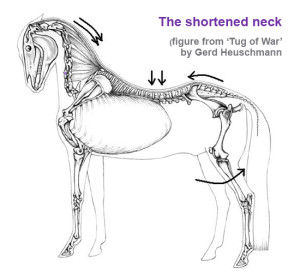 What often happens is this. An overtight saddle fits over the base of the withers like a clothes peg, pinching Trapezius thoracis and Longissimus dorsi. However, it frequently misses Spinalis thoracis where it surfaces, wholly or partially within the gullet space. Often, the muscle is partially affected.
What often happens is this. An overtight saddle fits over the base of the withers like a clothes peg, pinching Trapezius thoracis and Longissimus dorsi. However, it frequently misses Spinalis thoracis where it surfaces, wholly or partially within the gullet space. Often, the muscle is partially affected.
It’s as if the neighbouring muscles are under lockdown. Free movement of the shoulder is restricted and the horse’s ability to bear weight efficiently while moving is impeded. In response to the surrounding restriction and its own limitation, this muscle starts to overwork.
Result? The horse, which was probably already moving with an incorrect posture, hollows its back even further, shortening the neck and raising its head. As this becomes even more of a biomechanical necessity, all the muscles work even harder to maintain this ability to move, despite the compromised biomechanics.
Working harder and compensating for its neighbours, Spinalis becomes hypertrophic. It is doing what it was designed to do, but it’s now overdoing it and failing to release. We now have a rather nasty vicious circle.
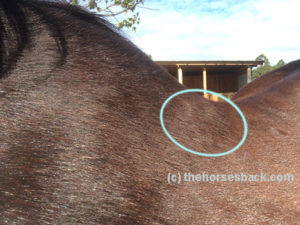
Here, Spinalis thoracis stands out due to atrophy of the surrounding musculature. In this TB, a clearly audible adjustment occurred in the C4-C5 area after the muscle was addressed.
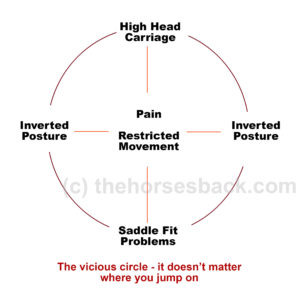 The Inverted Posture and Asymmetry
The Inverted Posture and Asymmetry
Of course, saddle fit is not the only cause of an inverted posture. However, any horse that holds its head and neck high for natural or unnatural reasons is more vulnerable to saddle fit issues, thus starting a cascade effect of problems.
Are there further effects of this hypertrophy? Consider the connections.
- When saddles are too tight, they’re often tighter on one side than the other. This can be due to existing asymmetry in the horse, such as uneven shoulders, uneven hindquarters, scoliosis, etc.
- On the side with greater restriction, the muscle becomes more more hypertrophic.
- With its attachment to the spinous processes of the lower cervical vertebrae, there is an unequal muscular tension affecting the spine.
- Without inherent stability, the neck and head are constantly being pulled more to one side than the other, with the lower curve of the spine also affected.
- Base of neck asymmetry affects the rest of the spine in both directions and compromises the horses ability to work with straightness or elevation.
- There is also asymmetric loading into the forefeet.
- We haven’t even started looking at neurological effects…
This isn’t speculation. I have seen this pattern in horses I’ve worked on, many times over.
So, How Do We Help?
In working with saddle fit problems, the saddle refit may be enough to help the horse, if the riding is appropriate to restoring correct carriage and movement. Obviously, the horse’s musculoskeletal system is complex and no muscle can be considered in isolation. As other muscles are addressed through therapeutic training approaches, with correct lateral and vertical flexion achieved, M. spinalis will be lengthened along with the surrounding musculature.
I hold with a restorative approach:
- Refit the saddle, preferably with the help of a trained professional,
- Remedial bodywork, to support recovery from the physical damage,
- Rest the horse, to enable healing of damaged tissue and lowering of inflammation, and
- Rehabilitate the horse, through the appropriate correct training that elevates the upper thoracics while improving lateral mobility.
This is particularly important where saddle fit has been a major contributor to the problem. I have frequently found that in these cases,correction will take longer to achieve, as the debilitating effects of poor saddle fit (especially long-standing issues) can long outlast the change to a new, better-fitting saddle. In bodywork terms, the hypertrophic M. spinalis cervicis is often the last affected muscle to let go.
It’s as if Spinalis cervicis is the emergency worker who will not leave until everyone else is safe.
Bodywork Notes
I am fortunate, in that my modalities enable the gentle release of joints through a non-invasive, neuromuscular approach. The responses I’ve had from horses when M. spinalis cervicis et thoracis has been addressed in isolation have been hugely informative.
** Questions, thoughts or comments? Join us at The Horse’s Back Facebook Group.
Appendix: Spinalis in the Textbooks
I’m going to add Spinalis references to this post on a regular basis, as I come across them. It’s interesting to see how much, or how little, the muscle is referenced in various textbooks.
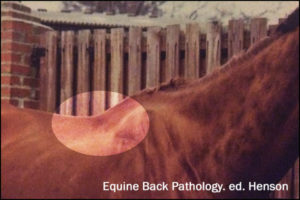
This image, from Equine Back Pathology, ed. F Henson 2009, shows acute atrophy of Longissimus dorsi due to neurological damage. It’s still possible to see the raised attachment/origin of Spinalis cervicis et thoracis – the highlighting is mine. Spinalis does not appear in the book’s index. (added 23 Dec 2016)
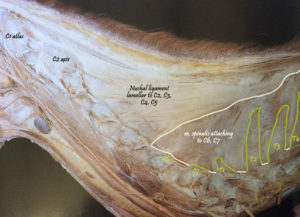 I have also altered this image, in order to show M. spinalis cervicis more clearly. This is Fig 2.16 from Colour Atlas of Veterinary Anatomy Vol 2, The Horse, R Ashdown and S Done. Spinalis cervicis is within the bounded area and it’s possible to see how it overlies the lamellar part of the nuchal ligament, lamellar portion. (added 23 Dec 2016)
I have also altered this image, in order to show M. spinalis cervicis more clearly. This is Fig 2.16 from Colour Atlas of Veterinary Anatomy Vol 2, The Horse, R Ashdown and S Done. Spinalis cervicis is within the bounded area and it’s possible to see how it overlies the lamellar part of the nuchal ligament, lamellar portion. (added 23 Dec 2016)
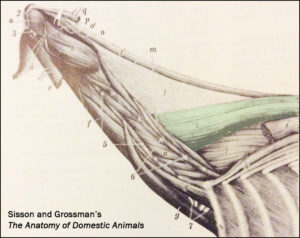 The muscle is tinted green in this image from Sisson and Grossman’s The Anatomy of Domestic Animals, Volume 1, fifth edition 1975. Here, it is labelled Spinalis et semi-spinalis cervicis. This anatomical figure is credited to an earlier text, Ellenberger and Baum, 1908. (added 23 Dec 2016)
The muscle is tinted green in this image from Sisson and Grossman’s The Anatomy of Domestic Animals, Volume 1, fifth edition 1975. Here, it is labelled Spinalis et semi-spinalis cervicis. This anatomical figure is credited to an earlier text, Ellenberger and Baum, 1908. (added 23 Dec 2016)
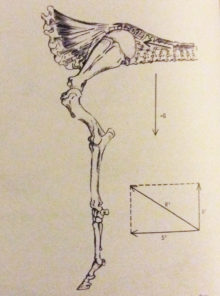 James Roony dedicates two pages to the ‘suspension bridge’ theory of the vertebral column in The Lame Horse (1988). His interest is in Spinalis dorsii section of the muscle and its effect behind the withers, in conjunction with Longissimus dorsii. (added 4 Jan 2017)
James Roony dedicates two pages to the ‘suspension bridge’ theory of the vertebral column in The Lame Horse (1988). His interest is in Spinalis dorsii section of the muscle and its effect behind the withers, in conjunction with Longissimus dorsii. (added 4 Jan 2017)
 Master Saddler Jochen Schleese refers to Spinalis dorsi and its function in stabilizing the withers in Suffering in Silence, his passionate book about saddle fitting from 2014. “This muscle area is especially prone to significant development – especially with jumpers – because it is continually contracted to accommodate the shock of landing”. The surface area of the muscle is indicated in the anatomical figure, reproduced here. (added 23 Dec 2016)
Master Saddler Jochen Schleese refers to Spinalis dorsi and its function in stabilizing the withers in Suffering in Silence, his passionate book about saddle fitting from 2014. “This muscle area is especially prone to significant development – especially with jumpers – because it is continually contracted to accommodate the shock of landing”. The surface area of the muscle is indicated in the anatomical figure, reproduced here. (added 23 Dec 2016)
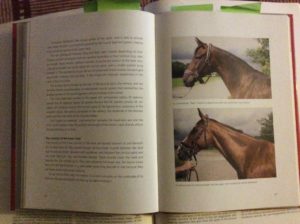 In his seminal text addressing issues of modern dressage training, Tug of War, 2007, Gerd Heuschmann includes Spinalis cervicis in the triangle formed by the rear of the rear of the cervical spine, the withers, and the shoulder blades, “… an extensive connection between the head-neck axis and the truck… it explains how the position and length of the horse’s neck directly affects the biomechanics of the back.” (added 31 Dec 2016)
In his seminal text addressing issues of modern dressage training, Tug of War, 2007, Gerd Heuschmann includes Spinalis cervicis in the triangle formed by the rear of the rear of the cervical spine, the withers, and the shoulder blades, “… an extensive connection between the head-neck axis and the truck… it explains how the position and length of the horse’s neck directly affects the biomechanics of the back.” (added 31 Dec 2016)
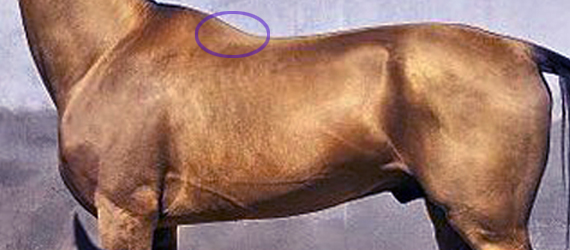
Thankyou ever so much for putting into words what I have been feeling or sensing for many years.
I always thought, each time I saw an Aussie horse with an apparently high narrow wither with no musculature, it was the saddle causing that problem.
But the general consensus is that Australian stock saddles are well suited for most Aussie type horses. How can this be so if soon after the horse begins life as a riding horse, the shape of its back changes dramatically to show this high bony wither with atrophied muscles?
Also the rider goes from siting nicely balanced atop the horse to being thrown forward as if perpetually riding downhill ? No amount of padding up the forward part of the saddle pad would change that situation as the horse continually modified it’s stance to avoid the new pressure. Finally the horse had a really dropped back.
I shudder to think of the amount of pain the poor horses were in continually & no wonder they always played up.
Hence the apparent need for a bigger bit! 8^[
And as you mentioned, then there are all the hoof problems caused.
Hi, thanks for commenting so quickly! I think it’s one more part of the puzzle, as so many different muscles (and joints) are affected by incorrect saddle fit and compromised movement.
Yes, that spiral you mention – the saddle is too tight, the muscle either side of the wither atrophies, and suddenly the saddle is dropping in front, because it’s now too wide for the reshaped horse. I struggle to explain this sometimes, how the saddle can be too narrow and too wide at the same time!
With Aussie stock saddles, I believe they were appropriately fitted when stock horses were working hard on the land, putting in long hours on reasonably basic feed. And I mean the TB-derived stock horses, not those with strong QH influence. The older styles are way too narrow for many modern leisure horses.
The day after I read your excellent article I came across a horse that showed exactly the symptoms you described.This sweet baby had been “managing” with ill fitting saddle for some years. He did this by keeping parts of his body so stiff that the saddle never caused saddle sores at the points where it was too narrow. The fysio has treated the effected places now. He never resisted being ridden, but the owner should have been alerted by his nervous behavior every time the saddle came in sight. With the info from your article I quickly convinced her there was a problem
Thanks to you he will never have to suffer that saddle again and he’s being helped to recover.
It’s great to hear that the article has helped your friend’s horse. I didn’t write it from the point of view that it’s always an indicator of poor saddle fit, but as it has helped you to make the point to someone who wasn’t seeing an issue – well, that’s just fantastic news!
Your comment, “He did this by keeping parts of his body so stiff that the saddle never caused saddle sores at the points where it was too narrow.” has just nudged me into remembering a parked blog idea that I may now revive…
Looking forward to that blog.
Thank you for an insightful piece – would you mind telling me what body work modalities you work in? Thank you
Hi, thanks for the feedback. No problem re the modalities. In approach I think structurally, working primarily with Equine Positional Release (this derives from human orthobionomy, which is pretty much Functional Therapy from osteopathy – non-invasive, non-force and working with the self-corrective reflex) and supported with Equine Touch (derives from Bowen roots, with some essential differences – but that’s another topic!).
you could also look into TTOUCH. they have some very good groundwork excises and body work you could try.
So happy you put This in writing, shares This, because we see it so often in my proffesion as Saddle and Equine Ergonomist and Saddlefitter
Thank you. 🙂
very interesting. i have a 18y 12hh mare who i got last year she is a high head carrier and slightly hollowed backed. she also has big white patches on either side were that muclse is.we think due to a bad saddle fit, i have been doing stretches with her and bending. good read,
Good article, keep up the good work. Even though I am retired now from the equine industry after 55 years. I still follow it with some interest. As I was co developer of the EquiScan Comper Pressure Mapping System for saddle fit and rider balance and a certified Saddle Fitter for Sharon Saare Saddle while Sharon was alive.
Hi Ray, thank you for the positive feedback. Your career with saddle fit assessment through mapping certainly sounds like a fascinating one.
I am simply pleased to contribute to and stimulate some more thought and discussion in the community. I was a little challenged in putting this post up, as I had to wonder why this topic wasn’t already under consideration by so many professionals with far greater knowledge than myself. However, I’ve taken my cue from the horses I work with and in my mind, if we’re consistently finding an area of pain in horses with certain postural patterns and limitations, then we need to ask why it is happening.
As you move forward you will continue to find area of pain and the cause needs to be researched as to why. I found over the years that the way a horse is trimmed or shod has a great effect on the causes of pain. (let me qualify myself here, I shod and trimmed horse for over 50 years on a professional scale) We also used pressure mapping to understand to a greater degree that horses will stand on a sore or lame leg longer then a sound leg when in motion. Couple poor trimming or shoeing with poor saddle fit and not only saddle but pads as well and you can have a very sore horse. there are three parts to the equation, proper balance of the entire horse, saddle and pad fit and rider balance that needs to be check that will cause pain for and in the horse. A book I suggest is “The Lame Horse” by Dr. James Rooney to start to understand balance and movement in relation the horse and all the subsystems of the horse. I always started with the hoof and moved up the bone column of the horse. By the way each one can be different from the other three. Just my thinking.
Absolutely re hoof balance, Ray 🙂 The book is already on my coffee table and I have further images to add to the article, as soon as I get around to it… he is one of the few writers to regularly mention t his muscle and in a whole body context too.
I might also say, proven with a number of blind study research projects that pad fit is also very important in paid and saddle fit. the number one thing is you can not pad away from pain. the horse must be balanced and pain free when fitting for correct saddle and pad fit. the best pad is a very thin 100% horse hair blanket/rug for only protecting the under side of a saddle. But they do not make horse hair pads any longer. One hundred percent wool came in second but still very thin. The rock and twist of the bars must fit the conformation of the horse or the panels must be correct flocked. The best material for panels is 100% wool. String, cotton, paper, rat, dog, rabbit hair does not work. Pain can be created by an incorrect pad. Pain can be created by a lot of different man made material. Because the material dies over time and becomes hard, in the manufacturing process a lot of time hard spots can be created. Some thing I found very interesting is if a male rider has a wallet in his hip pocket that point of pressure can be transferred down to the horse back through the saddle and pad, causing a pressure point on the horses back. As I stated above rider balance is also very important. In our research we found very few people that could keep proper balance while on the horse back. That most were riding to one side or the other, too far forward or backward to keep the horse comfortable and not create stress. We also incorporated Thermal Imaging and pressure mapping on some of our research both at UM and OSU. Pressure creates heat and heat creates pain. There is also shearing pressures that need to be address, this again is how the rider rides and the fit of the saddle and pad. Just what I found out over the years.
With reference to thermal imaging, what did you think of the Soc of Master Saddlers (UK) research using a Pliance sensor mat and thermal imaging to assess saddle fit? They found that areas of pressure did not necessarily produce heat. More often pressure either side of the withers was cool, while pressure to the rear of the panels did create heat patterns. The results were inconsistent in this way (I must read it again).
I feel this is due to the amount of pressure being applied. Most tissue damage I found due to pressure is above 3mm. Starting there the heat also seem to increase. Some time we found that the pressure was not constant allowing the skin to cool. Also one needs to take in shearing movement of both the saddle and pad. Shearing forces can be seen ever with out a pressure map. It is notice at the back of the saddle where the hair is, shall we say sheared or rub off. You can also have this same force at work along the side of the horse where your fenders are on western saddle or your leathers on English type saddles.
Hiya,
Sorry to gatecrash this Q&A you guys have going, but I’m in the middle of writing a dissertation on ill-fitting saddles and the relation to clinical manifestations of pain and back pathologies. I am using a Tekscan CONFORMat as apposed to the Pliance mat (our uni only has a Tekscan) but iv had to research papers from Hilary Clayton (she uses the pliance mat) so I can get object info on the various technologies available and there pros and cons etc. (I digress, but hang in there il get to the point) – The pliance mat I found to be superior over the Tekscan in only 1 way – it is not a whole unit like Tekscan is (picture the shape of a dressage saddle pad that’s what Tekscan looks like). The pliance mat has a gap down the middle (longitudinally along the dorsal aspect of the thoracolumbar spine) and as such, this eliminates the likelihood of false recordings of focal areas of pressure that may arise (with the Tekscan design ie; no gap) as the rider mounts (irrespective of how lightly or evenly). The downwards force of the riders weight in the saddle can cause the mats without the spinal clearance the pliance has to displace the pressure mat and thus appear to impinge the spinous processes when infact the spine has clearece its just the mat being pulled down as the riders weight is added to the saddle. Additionally, (appologies in advance if you already know this) but in response to the comment “research using a Pliance sensor mat and thermal imaging to assess saddle fit? They found that areas of pressure did not necessarily produce heat. More often pressure either side of the withers was cool, while pressure to the rear of the panels did create heat patterns. The results were inconsistent in this way” The main reason for this (and this is a commonly known limitation of ALL pressure sensing devices) they only measure the pressure perpendicular to the surface – and although perpendicular pressure is the most accurate, and its possible that pressure at an angle may be recorded, though it will likely register at lower than the true value and as such is not reliable in terms of object evidence. lastly, both the size of and spatial distribution of the sensors in each different kind of mat effects the coverage of the measured area. if sensor coverage is insufficient, total force measurements will be erratic due to inconsistencies in the number of sensors activated and small focal areas of high pressure can be missed (or as you put appear to not show any heat, which could also be possibly due to a breakdown in communications with the central nervous system as a result of chronic focal pressure causing failed motor neuron signals from the spinal cord and damage to nerve endings etc) ……….but that’s just my two pennies worth hahaha! anyway, hopefully some of that may be of interest to you guys and maybe even help……either way, I love this blog (cant believe iv only just found it) and fully support both your views and appreciate your passion.
Hi Lolly,
Sounds like a great dissertation! So would you find thermographic evidence useful at all then?
Interesting. Following. I too utilize Vista Medicals forced sensory array system on horses. Primarily for research. There are dozens of variables using it. One must be wide open very open minded Great read.
i am trying to research the best fitting saddle I can find for my horse,one that fits evenly along his spine. He has terrific movement in his back which is a double edged sword and I’ve tried to do the right thing and failed. Now I don’t know in which direction to turn as the more research I do the more I realise I can make the wrong decision so much easier than the right one and I owe it to him not to experiment further.. Help anybody?
Wow this hits the nail on the head for me! I have been dealing with the side affects of this issue for years and every time I take my horse to the vet they look at his feet. Every vet has a different answer as to what is wrong, not one of them has identified this muscle as the issue. One side did atrophy as you discribed. I have not sat on my horses back for 2 years, the western saddle is the culprit on my American Saddlebred. I have had a equine chiropractor come out and adjust him every week for 6 months, then every other week for 6 months, then once a month. It has helped a lot but every time I put the western saddle on his back and sit in it he looks lame at the trot. He can walk and canter but not trot. I could see that he had trouble raising his head to the correct position. I was thinking of getting the Circle Y flex saddle, but they are super expensive. My horse would be a text book case for this issue. I have printed this article to take to my Chiropractor. He is much better now but I feel like I can’t ride him. Will driving him help strengthen that muscle? And what other exercises can I do to help him fell more comfortable.
Hi, thank you for posting this. My point with this muscle is that it’s a bit like the ‘last man standing’ after other parts of the musculoskeletal structure are compromised, frequently due to poor saddle fit. Usually, it’s affected by other problems, rather than being the cause of the problem – until, that is, other issues are resolved but it remains hypertrophic and shortened.
What I would try to find out is whether your horse is misaligned through the vertebrae at the base of the neck, so that’s C6-C7 and T1-4. This is very, very common. If so, you might find that the spinalis muscle is more pronounced and sore on one side.
And it does sound as if that saddle fit needs checking, as you say.
Wishing you luck 🙂
Is it possible for this muscle to become sore through dental work? My mare had had a tooth removed before I got her and regular sessions are slowly helping her mouth but one session was quite intense and she’s never really felt happy since that. Her movement shut down and I’m wondering if this muscle could have been affected?
I really couldn’t say. I’ve sometimes found some horses to be tight in the muscles of the upper neck after dental work, so maybe it’s worth looking at the cervical muscles and joints as well, of course, as the temperomandibular joint.
this is something I fix every day as an Equine Chiropractor love to talk to you Jane
Happy to talk here, Dave!
Excellent article. This plays a role in what I term, “forehanditis”. There is more to the picture, however. That is of the feet, specifically “high/low heel syndrome”, which is all part of the “asymmetrical syndrome “, of postural distortions.
Everything affects everything! It is all part of a picture, nothing is excluded 🙂
Very interesting read! And very timely for me, as next week I’ll be picking up a new Paso Fino mare who shows clear concern about being saddled and mounted. It’s visible in the videos the current owner has sent me; she’s only had the mare for two weeks, having outbid the kill buyer at a local sale. She hasn’t even ridden the mare as she realized she didn’t have a saddle that fit her. This article puts another tool in my toolbox for working with this mare.
Wishing you the best of luck, Jan.
Thanks, very interesting. I have a mare who showed obvious wasting in the area that I now recognise as spinalis. I had the chiropractor see her and he thought she was sore over C3/C4 area and manipulated that. Are they likely to be related? I’m having trouble finding anything linking the two.
Hi, when you say obvious wasting, do you mean hollowing alongside the withers and behind the scapula? It’s more normal to have wasting in the thoracic trapezius and long back muscles, with a bulking up of the small area of spinalis that can be seen and palpated…
Yes, seems to be behind the scapula. Could be trapezius I guess. Or maybe that side is normal and the other side is overdeveloped
Hello – this was an interesting read – I was wondering if you can offer some insight into a horse I work with. He seems to have exactly what you describe and show in this article, the small muscle at lower wither more to the left but coming up and over and slightly to the right, all suggesting a poorly fitting saddle. The horse in question however has been out of work for a year with a severe case of laminitis so we know that this isn’t the case. He’s not sore on it and likes us massaging it, but it isn’t going down? Any suggestions?
Hi! It’s certainly multi-factorial and severe laminitis would have created considerable tension through the forequarters and back through pain-related tension and postural change. This horse will need rehab work to mobilise the back again and redevelop muscle. Laminiitis really does affect the whole body, as I’m sure you know!
It’s also worth mentioning, although it may not be the case here, that muscle atrophy due to saddle fit doesn’t correct simply because a saddle is taken away or the horse is out of work – rehabilitative work is always needed to rebuild the back muscle.
I’m working on this problem with my horse, and won’t leave a question now since prior comments are over a year old. But will fill in my info. so as to receive notification of new posts.
Hi Betsey,
The comments tend to come in spurts, depending on the circulation of the articles. Many people have notifications switched on, so you may get responses 🙂 If you join the FB group, lots of people there are more than willing to discuss back and saddle issues, with many of them being very qualified to do so!
Fabulous article, so educational!!!! Thank you very much for writing it!!!!!
Hi there! I know I’m a bit late to this discussion, but there is a horse that recently arrived at my barn that fits this perfectly. He has an overly pronounced spinalis evenly on both sides of his spine. The muscle is as hard as a brick and he’s considerably reactive even to light palpation. When we saddle/girth him he reaches back with his head and touches us, though he has such an incredibly sweet disposition and doesn’t try and bite. We do not have whatever saddle he had at his previous owner’s, but in every saddle he’s been ridden in here it slides back considerably. He’s not my horse, but I can see he’s in pain, and I’d like to recommend the owner that they have him checked out. What course of action would you recommend (be it chiro, massage, etc?) I know his owners wallet is not unlimited, so I’d want to recommend something that would help the most rather than send them on a wild goose chase to find the solution…
It’s obviously hard to say without seeing the horse, but… The best option would be to do some training, in hand, to help the horse open up through the thoracic sling, lift the spine up and lengthen his neck. Horses such as this are usually hollow or flat through the back, with the ‘upside down’ neck appearance. They are dropped through the sternum.
I would favour an osteopathic approach or a veterinary chiro who does acupuncture – massage alone will help, but not with the deeper spinal correction at the cervicothoracic junction.
Saddle fit obviously needs improving, although this horse will change shape a lot with *correct work… ALso, check for underrun heels in the fores, as these add to the poor posture and hollowing behind the scapulae.
Good luck! This is a lucky horse!
I have recently got an OTTB for light trail / paddock rides. I had my saddle fitter out and we noticed his high wither, but he’s also got big shoulders. We decided on a changeable gullet and flocking for him as she has to accommodate the shoulders being wide and the wither high. She also pointed out the atrophy was definitely a previous saddle fit issue, not taken his shoulders into account and therefore causing the atrophy. I am working in hand and hopefully we can rebuild his whole topline because the shoulders have most certainly affected his spinal muscles. Thanks for the great information, having a great saddle fitter is a necessity in my opinion, they’re worth their weight in gold.